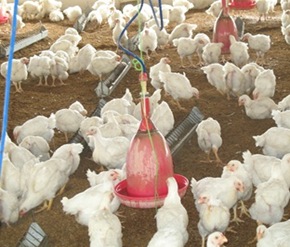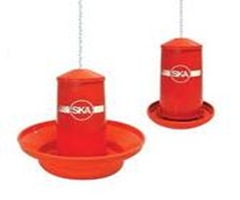Poultry-Housing System
HOUSING IN POULTRY
POULTRY-Housing System
The poultry house requires certain features for the better farming of poultry. They are:
1. The poultry houses or farms are to be located in non-residential areas so that the poultry is away from noise, dust, etc.
2. The farm should be constructed in such a way that it maintains good environmental conditions.
3. The farm should be elevated from the ground. Due to this, water may not get into the farm during rainy season.
4. The poultry farms are to be constructed in east to west direction along their length. As a result, good sun-shine is available.
5. The farm is to be located in a place where transport facilities are available. Water, electricity, feed and equipment are to be within the reach of the farm.
6.The farm is to be located near the consumer areas.
7. The poultry housing also requires proper temperature and light. At 30° C, the chicken can lay eggs well. Electric bulbs should be arranged at a height of 7ff. in poultry farms to provide warmness. These lights are to be switched on during first seven weeks. A relative humidity of 50-60% is ideal for poultry.
8. The sheds are to be ventilated properly. Proper ventilation helps in providing sufficient oxygen for birds and removes harmful gases such as ammonia and carbon dioxide. It also removes moisture in the house and helps in keeping optimum temperatures. To facilitate ventilation, the farm house is to be constructed in such a way that it should have an open front, adjustable windows or cloth covered frames and ventilation at ridge level.
9.The flooring of poultry house is to be constructed either with cement or napa slabs. Its roof is to be constructed either with palmyra leaves or cement sheets.
10. The chicken in a poultry farm are to be fed with sufficient food and water. Food troughs and water troughs are to be arranged depending on the size of poultry farm. The egg laying pots are also to be established in poultry sheds. One food trough is to be kept for every 20 fowls. The food troughs should not be filled completely with food material. The water given to fowls should be always clean and sufficient.
There are two important housing systems in poultry farms. They are
1. Deep litter system and 2. Cage system
1. Deep litter poultry system
This is the conventional housing system of poultry farms practiced since long back.
The floor in the poultry farm is tube covered with a layer of saw dust, paddy husk or straw. This layer is about 4 inches in thickness in summer, while in other seasons 7 inches thick layer is used on the floor. This layer of saw dust, paddy husk or straw which covers the floor of the poultry farm is called litter. The litter should be always
in dry condition. The droppings of birds produce ammonia. In wet condition, more ammonia in the litter may cause diseases. Hence, it should be mixed periodically with lime to reduce the percentage of ammonia in the litter. Further the litter should be changed once in a year. Growing chicken on floor covered by litter is said to be the Deep litter system (deep litter) or loose housing system.
The dimensions of the poultry house depend on the number of chicks to be accommodated. For example, 125 chicks require a space of about 400 square feet. A chick normally requires 2.25 square feet. It should be remembered that more than 250 chicks should not be accommodated in a poultry house. A distance of 40 feet is to be maintained in between two poultry houses or sheds.

2. Cage System in Poultry
Of late, many farmers are growing chicks by using cage system. In this system, the birds are grown in cages made of iron mesh. For growing about 25 fowls a cage measuring is 36” x 48” is used. Lesser dimension cages are used for growing small flocks. The cages are arranged in 2 or 3 tiers in poultry houses. Feeding, watering and other facilities are given to the chicken introduced in these cages.
cage method in Poultry-advantages:
1. In this method, there is no wastage of space and food.
2. Chicks involved in cannibalism may be easily identified and removed. Cannibalism in poultry is referred to as one bird pecking at the other bird.
3. The diseased birds can easily be separated.
4. Less labor is involved in this method.
5. Collection of eggs is an easy process.
6. Mortality rate is less in this system.
cage system disadvantages they are:
1. The cracked eggs are common.
2. It is difficult to clean the individual cages and to dispose the manure.
3. The food may not be distributed accurately depending on the consumption of the birds in the cage.
4. The birds are frequently subjected to a disease called cage layer fatigue. The bird lies on its side giving an impression that it is affected with paralysis. Hence, this is referred to as cage paralysis or cage layer fatigue.
5. Fatty liver syndrome is common in cage system. It is characterised by
i) a gradual drop in egg production (40% - 10%),
ii) fatty, enlarged, tan colored liver is noticeable, and
iii) birds become fatty.
In cage culture certain precautions are to be followed. They are:
1. In summer, water is to be sprinkled on cages. This is due to the fact that cage poultry needs protection from excessive heat in severe summer.
2. The chicks should be subjected to dubbing and debeaking. As a result of debeaking, the chicken may not involve in cannibalism and can easily procure the soft food without waste.
POULTRY-Equipment

Depending on size and type of poultry farm, various types of equipment are to be used in poultry farms. The number and size of the equip mental sovary. Important poultry house equipment includes Perches, Feed hoppers, Watering devices, De beakers, Chick guards, Laying nests, Brooding hovers etc.
